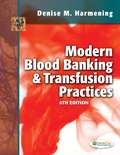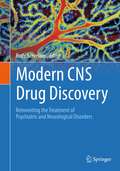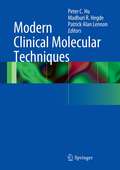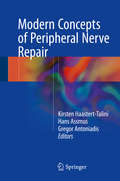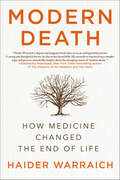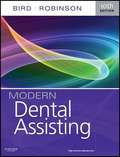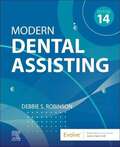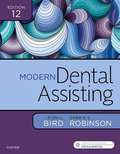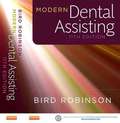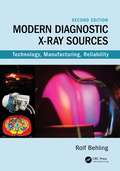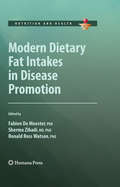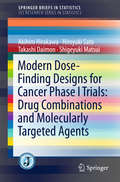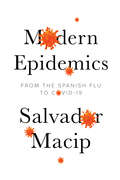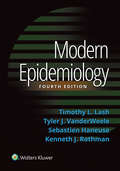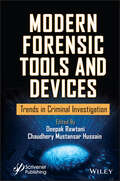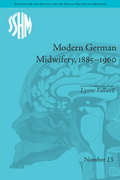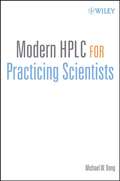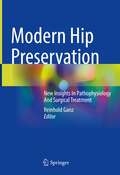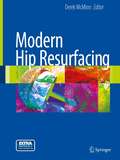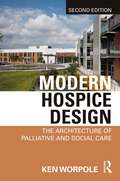- Table View
- List View
Modern Blood Banking and Transfusion Practices
by Denise M. HarmeningThoroughly revised and updated, the 6th Edition of this popular text continues to set the standard for developing a comprehensive understanding of modern routine blood banking and transfusion practices. Building from a review of the basic sciences to the how and why of clinical practice, this text is the ideal guide to immunohematology and transfusion practices.
Modern Breast Cancer Imaging
by Su Jin Kim Hsieh Elizabeth Anne MorrisThe available information on breast cancer has evolved so rapidly that a textbook understanding is no longer sufficient to make sound therapeutic decisions. Further, the latest findings and data are spread throughout the scientific literature of various medical fields, making it difficult for medical professionals to keep abreast of these advances, and to apply them in their day-to-day work. This book provides updated information on breast cancer, such as the modern molecular classification and staging, and demonstrates how imaging with pathologic correlation can be used in management decisions. In addition, it identifies the most suitable imaging modalities for screening, diagnosis and monitoring for each clinical case. Given its scope, the book offers a valuable resource for all medical professionals (practicing or still in training) whose work involves breast cancer, including radiologists, breast surgeons, pathologists, radiotherapists and nuclear medicine professionals.
Modern CNS Drug Discovery: Novel Therapeutics for Psychiatric and Neurological Diseases: From Target Identification to Regulatory Approval
by Rudy SchreiberThis new edition is a comprehensive guide to the intricate world of drug discovery and development. It provides readers with an update on basic and novel concepts, approaches and technologies that are used in the discovery and development of new therapeutics for diseases of the central nervous system (CNS). A major aim is to support the education of professionals and specialists in the biomedical neurosciences that will become the innovators, entrepreneurs, and leaders of the future. The educational focus is now enhanced by the inclusion of over 150 study questions available in the free Springer Nature Flashcard App, which makes this a unique book in its field. Divided into five sections, the book starts by introducing concepts and ideas to inspire the next generation of life scientists pursuing careers in drug discovery for CNS diseases. In the following section, key strategies and methods for identifying and testing novel drug targets are described. New chapters on important topics have been added, that is, the blood brain barrier, mass spectrometry, biased signaling and the exposome. The third section highlights strategies and technologies in translational CNS drug discovery and looks at safety and drug metabolism assessment, imaging techniques and functional testing to investigate drug treatment outcomes. The chapters in the fourth section address the emergence of transdiagnostic approaches as exemplified by the Research Domain Criteria initiative and non-invasive brain stimulation techniques. Finally, the book concludes with the late stages of drug development, such as the planning and performance of clinical trials, and regulatory approval. Written by experts from academia and industry, the book covers important fundamentals and best practices as well as current developments in neurotherapeutic research. It offers in-depth insights into the world of drug development and is essential reading for young scientists who are interested in translational research and want to prepare for an academic or industry career in CNS drug discovery.
Modern CNS Drug Discovery: Reinventing the Treatment of Psychiatric and Neurological Disorders
by Rudy SchreiberThis textbook provides a comprehensive overview of the currently used concepts, approaches and technologies in the discovery and development of new treatments for the full spectrum of disorders of the central nervous system. It guides the reader through all essential steps, from finding an innovative idea, to the registration of a new drug.Divided into four sections, the book starts by presenting a broad perspective on current approaches in central nervous system (CNS) drug discovery. The second section addresses the generation of ideas for the identification of targets and novel treatment strategies; covers core functions in early discovery, and provides an example of a novel treatment paradigm: brain stimulation. The third section highlights strategies and technologies in translational CNS drug discovery. In an effort to bridge the gap between discovery and clinical development, it also covers brain imaging, EEG and cognitive testing approaches. The fourth section extensively discusses the clinical phase of drug development, covering the basics of early clinical testing for psychopharmacological drugs. The book’s final chapter addresses the registration for newly developed drugs. Written by experts from academia and industry, the book covers important basics and best practices, as well as recent developments in drug discovery. Offering in-depth insights into the world of drug development, it represents essential reading for early researchers who want to prepare for a career in drug discovery in academia or industry.
Modern Clinical Molecular Techniques
by Peter Hu Patrick Alan Lennon Madhuri HegdeThis timely book covers the need to know clinical practices for all those involved in molecular laboratory science. The field of molecular medicine is evolving at an astounding speed. Propelled by the new insights and technologies, advances are being made at an unprecedented rate. With dual measure given to today's breakthroughs, this book is a collection of the most current practices relevant to the clinical molecular laboratorian. It begins with an introductory section on techniques and procedure. It then presents four separate sections on infectious disease, oncology, pre/post-natal, and identity testing, with specific chapters clearly outlining clinical protocols used in daily practice. Modern Clinical Molecular Techniques cuts to the heart of what is essential for the practicing molecular laboratory scientist. It is an outstanding resource for those operating within or looking to set up a clinical molecular laboratory.
Modern Clinical Trial Analysis
by Wan Tang Xin TuThis volume covers classic as well as cutting-edge topics on the analysis of clinical trial data in biomedical and psychosocial research and discusses each topic in an expository and user-friendly fashion. The intent of the book is to provide an overview of the primary statistical and data analytic issues associated with each of the selected topics, followed by a discussion of approaches for tackling such issues and available software packages for carrying out analyses. While classic topics such as survival data analysis, analysis of diagnostic test data and assessment of measurement reliability are well known and covered in depth by available topic-specific texts, this volume serves a different purpose: it provides a quick introduction to each topic for self-learning, particularly for those who have not done any formal coursework on a given topic but must learn it due to its relevance to their multidisciplinary research. In addition, the chapters on these classic topics will reflect issues particularly relevant to modern clinical trials such as longitudinal designs and new methods for analyzing data from such study designs. The coverage of these topics provides a quick introduction to these important statistical issues and methods for addressing them. As with the classic topics, this part of the volume on modern topics will enable researchers to grasp the statistical methods for addressing these emerging issues underlying modern clinical trials and to apply them to their research studies.
Modern Concepts of Peripheral Nerve Repair
by Hans Assmus Gregor Antoniadis Kirsten Haastert-TaliniThis book focuses on posttraumatic repair and reconstruction of peripheral nerves. Written by internationally respected specialists, it provides an overview of the challenges and the latest advances in diagnosis and treatment of traumatic peripheral nerve injuries. It presents an outline of state-of the-art procedures from diagnostics, including newest imaging techniques, over conventional and alternative surgical approaches to clinical follow-up and rehabilitation, including the latest concepts to improve functional recovery. The purely clinical topics are preceded by neuroanatomical principles and neurobiological events related to peripheral nerve transection injuries and followed by an outlook on current experimental developments in the area of biomaterials for artificial nerve grafts and peripheral nerve tissue engineering. Peripheral nerve injuries not only affect the nerve tissue at the site of injury, but also target tissue and parts of the central nervous system. They often have dramatic consequences for patients, including loss of sensory and motor functions combined with paresthesia or pain, and a reduced quality of life and ability to work. An adequate understanding of the procedures for proper decision-making and reconstructing peripheral nerves is therefore essential to ensure optimized functional recovery.
Modern Death: How Medicine Changed the End of Life
by Haider WarraichThere is no more universal truth in life than death. No matter who you are, it is certain that one day you will die, but the mechanics and understanding of that experience will differ greatly in today’s modern age. Dr. Haider Warraich is a young and brilliant new voice in the conversation about death and dying started by Dr. Sherwin Nuland and Atul Gawande. Dr. Warraich takes a broader look at how we die today, from the cellular level up to the very definition of death itself. The most basic aspects of dying—the whys, wheres, whens, and hows—are almost nothing like what they were mere decades ago. Beyond its ecology, epidemiology, and economics, the very ethos of death has changed. Modern Death, Dr. Warraich’s debut book, will explore the rituals and language of dying that have developed in the last century, and how modern technology has not only changed the hows, whens, and wheres of death, but the what of death. Delving into the vast body of research on the evolving nature of death, Modern Death will provide readers with an enriched understanding of how death differs from the past, what our ancestors got right, and how trends and events have transformed this most final of human experiences.
Modern Dental Assisting
by Debbie S. Robinson Doni L. BirdPrepare for a successful career as a dental assistant! Modern Dental Assisting is the leading text in dental assisting -- the most trusted, the most comprehensive, and the most current. Using an easy-to-understand approach, this resource offers a complete foundation in the basic and advanced clinical skills you must master to achieve clinical competency. It describes dental assisting procedures with photographs and clear, step-by-step instructions. Written by Doni Bird and Debbie Robinson, two well-known and well-respected dental assisting educators.Comprehensive coverage takes students through a dental assisting program from start to finish. A highly approachable writing style presents the latest information and procedures in a way that ensures students can easily grasp and learn to apply the material. Concise chapters presented within short parts move from profession basics and sciences to infection control, safety, clinical dentistry, radiography, materials, specialty dental practice, and dental office administration. Superb, full-color illustrations and photographs show procedures, equipment, and instruments. Illustrated, step-by-step procedures show the skills that dental assistants must master, detailing for each the goal, equipment and supplies needed, chronological steps, and rationales. Expanded Functions procedures boxes describe special dental assisting procedures allowed only in certain states. Procedure icons alert students to issues relating to core procedures, e.g., that they should make notes in the patient's record, don personal protective equipment, or watch for moisture contamination. Key terms are accompanied by phonetic pronunciations, highlighted within the text, and defined in boxes on the same or facing page. Critical thinking questions end each chapter with mini-case scenarios and application-style questions. Learning and performance outcomes in each chapter set goals for what students will accomplish and also serve as checkpoints for comprehension, skills mastery, and study tools for exam preparation. Summary tables and boxes make it easy to review key concepts and procedures. Recall boxes appear after sections of text and include questions to ensure that students understand the material. CDC boxes cite the latest recommendations for infection control and summarize regulations. Eye to the Future boxes introduce cutting-edge research, future trends, and topics. Legal and Ethical Implications boxes focus on the behaviors that dental assistants will need to practice to protect themselves, their patients, and the practices for which they work. Patient Education boxes summarize content within the context of patient education take-away points. A glossary provides a quick and handy way to look up terminology, with chapter references indicating where terms are introduced and discussed within chapters.
Modern Dental Assisting
by Debbie S. RobinsonEasily master all aspects of dental assisting with the most up-to-date and trusted text available. For more than 45 years, students and practitioners alike have relied on Modern Dental Assisting for its cutting-edge content, easy-to-grasp writing style, step-by-step procedures, and top-notch visuals. And the new 14th edition is no exception. With updated content ― including the latest technological advancements, clinical photographs, and coverage of cultural diversity and how it relates to patient care ― this new edition will guide you from your first day of class all the way to your first job in dental assisting.
Modern Dental Assisting
by Doni L. Bird; Debbie S. RobinsonThe 12th edition showcases a brand-new illustration program and content on technological advances, public health and access to care, tele dentistry, infection control guidelines, the Zika virus, Ebola, the oral-systemic health connection, and much more. <P><P>Written by trusted experts Doni Bird and Debbie Robinson, this is the all-in-one learning resource you need to stay ahead of the curve in the modern world of dental assisting.
Modern Dental Assisting (11th Edition)
by Debbie S. Robinson Doni L. BirdPrepare for a successful career as a dental assistant with Modern Dental Assisting, 11th Edition! Using an easy-to-understand approach, this book provides a complete foundation in the basic and advanced skills you must master to achieve clinical competence.
Modern Diagnostic X-Ray Sources: Technology, Manufacturing, Reliability
by Rolf BehlingNow fully updated, the second edition of Modern Diagnostic X-Ray Sources: Technology, Manufacturing, Reliability gives an up-to-date summary of X-ray source technology and design for applications in modern diagnostic medical imaging. It lays a sound groundwork for education and advanced training in the physics of X-ray production, X-ray interactions with matter, and imaging modalities and assesses their prospects. The book begins with a comprehensive and easy-to-read historical overview of X-ray tube and generator development, including key achievements leading up to the current technological and economic state of the field. The book covers the physics of X-ray generation, including the process of constructing X-ray source devices. The stand-alone chapters can be read in order or in selections. They take you inside diagnostic X-ray tubes, illustrating their design, functions, metrics for validation, and interfaces. The detailed descriptions enable objective comparison and benchmarking. This detailed presentation of X-ray tube creation and functions enables you to understand how to optimize tube efficiency, particularly with consideration for economics and environmental care. It also simplifies faultfinding. Along with covering the past and current state of the field, the book assesses the future regarding developing new X-ray sources that can enhance performance and yield greater benefits to the scientific community and to the public. After heading international R&D, marketing and advanced development for X-ray sources with Philips, and working in the X-ray industry for more than four decades, Rolf Behling retired in 2020 and is now the owner of the consulting firm XtraininX, Germany. He holds numerous patents and is continuously publishing, consulting and training.
Modern Dietary Fat Intakes in Disease Promotion
by Ronald Ross Watson Sherma Zibadi Fabien De MeesterThe industrial and agricultural revolutions have dramatically changed our lifestyles including where we get foods and what we eat. Modern diets have moved away from a close association with historically beneficial foods and diets towards foods and diets with increased fats and contaminants and with much lower intakes of fruits and vegetables. Modern Dietary Fat Intakes in Disease Promotion focuses on the scientific evidence that define such risks in modern diets with the consequences of increased illness, cancer and disease. There is also an emphasis on methods to reverse negative components of modern diets for health improvement. The volume is divided into six sections. The first section focuses on the behavioral aspects of eating and is followed by sections on fats, obesity and cardiovascular disease and fats and cholesterol. The fourth section contains novel chapters on the potential for contaminants in fats and oils to increase risk of illnesses. The fifth section examines fat induced disease and ill-health. The sixth section looks at dietary and pharmaceutical approaches to modify fat-induced disease and ill-health. Each section contains chapters that address treatment options as well as prevention strategies. Modern Dietary Fat Intakes in Disease Promotion provides practical, data-driven resources based upon the totality of the evidence to help the reader understand both the basics as well as treatments and preventive strategies that are involved in balancing the fats in one's diet as well as within one's body.
Modern Dose-Finding Designs for Cancer Phase I Trials: Drug Combinations and Molecularly Targeted Agents
by Shigeyuki Matsui Akihiro Hirakawa Hiroyuki Sato Takashi DaimonThis book deals with advanced methods for complex phase I and phase I/II dose-finding clinical trials with multiple drugs and outcomes in oncology. It provides not only methodological aspects of the dose-finding methods, but also software implementations and practical considerations in applying these complex methods to real cancer clinical trials. Thus, the book aims to furnish researchers in biostatistics and statistical science with a good summary of recent developments of complex dose-finding methods as well as providing practitioners in biostatistics and clinical investigators with advanced materials for designing, conducting, monitoring, and analyzing complex dose-finding trials. The topics in the book are mainly related to cancer clinical trials, but many of those topics are potentially applicable or can be extended to trials for other diseases. The focus is mainly on model-based dose-finding methods for two kinds of phase I trials. One is clinical trials with combinations of two agents. Development of dose-finding methods for two-agent combination trials requires reasonable models that can adequately capture joint toxicity probabilities for two agents, taking into consideration possible interactions of the two agents on toxicity probability such as synergistic or antagonistic effects. Another is clinical trials for evaluating both efficacy and toxicity outcomes in single- and two-agent combination trials. These methods are often applied to the phase I trials including molecularly targeted agents (MTAs) because the toxicity and efficacy for a MTA does not monotonically increase with dose, but the efficacy often increases initially with the dose and then plateaus. Successful software implementations for several dose-finding methods are introduced in the book, and their operating characteristics in practice are discussed. Recent applications of the above-mentioned adaptive dose-finding methods in drug developments are also provided.
Modern Electroencephalographic Assessment Techniques
by Vangelis SakkalisModern Electroencephalographic Assessment Techniques: Theory and Applications presents numerous signal processing and connectivity analysis methodologies addressing a wide variety of clinical applications including epilepsy, schizophrenia, Alzheimer's disease and even alcoholism. Among the different topics addressed, the neurophysiological basis of cognitive processes is also investigated. The goal is to provide a comprehensive overview of the most modern and widely established approaches mainly applied in, but not limited to, decomposing high resolution multichannel Electroencephalography (EEG) and Magnetoencephalography (MEG) signals into functional interconnected brain regions. Synergistic approaches linking both EEG/ MEG and functional Magnetic Resonance Imaging (fMRI) techniques are also discussed. In line with the popular Neuromethods series, chapters present the theoretical basis of each method along with prosperous application domains, in the form of a balanced mixture of theoretical tutorials, comprehensive reviews and original research. Emphasis is given to the underlying assumptions, to technical matters that greatly affect the outcome of each proposed method, to the ambitions and to the domain of application of each method. Furthermore, links to graph theory and visualization of connectivity motifs is also addressed in an attempt to better describe the functional characteristics of brain networks. Authoritative and practical, Modern Electroencephalographic Assessment Techniques: Theory and Applications touches upon both the biomedical and computational aspects of this exciting and rapidly evolving field and will allow for a more in-depth, vital understanding of the brain's complex underlying mechanisms.
Modern Epidemics: From the Spanish Flu to COVID-19
by Salvador MacipCOVID-19 has made us all aware of the fact that we live in a world full of invisible enemies. Normally, we don’t even realize they’re there, but from time to time one of these microscopic creatures becomes powerful enough to turn everything upside down. What are these invisible enemies, and how can we prepare ourselves for the pandemics of the future? A specialist in the cellular biology of diseases, Salvador Macip explains, in a language everyone can understand, what it means to share the planet with millions of microbes – some wonderful allies, others terrible foes. He provides a concise account of epidemics that changed history, and focuses on the great modern plagues that are still causing millions of deaths every year, from influenza, TB and malaria to COVID-19. Macip also examines the methods we have used – from vaccines to improved sanitation and social distancing – to try to control these invisible enemies. This authoritative overview of modern epidemics and the pathogens that cause them will be essential reading for anyone who wants to understand our world today, a world in which some of the greatest threats to the human species come from the invisible microbes with which we share this planet.
Modern Epidemiology
by Timothy L. Lash Tyler J. VanderWeele Sebastien Haneause Kenneth RothmanNow in a fully revised Fourth Edition, Modern Epidemiology remains the gold standard text in this complex and evolving field. This edition continues to provide comprehensive coverage of the principles and methods for the design, analysis, and interpretation of epidemiologic research. Featuring a new format allowing space for margin notes, this edition • Reflects both the conceptual development of this evolving science and the increasing role that epidemiology plays in improving public health and medicine. • Features new coverage of methods such as agent-based modeling, quasi-experimental designs, mediation analysis, and causal modeling. • Updates coverage of methods such as concepts of interaction, bias analysis, and time-varying designs and analysis. • Continues to cover the full breadth of epidemiologic methods and concepts, including epidemiologic measures of occurrence and effect, study designs, validity, precision, statistical interference, field methods, surveillance, ecologic designs, and use of secondary data sources. • Includes data analysis topics such as Bayesian analysis, probabilistic bias analysis, time-to-event analysis, and an extensive overview of modern regression methods including logistic and survival regression, splines, longitudinal and cluster-correlated/hierarchical data analysis, propensity scores and other scoring methods, and marginal structural models. • Summarizes the history, specialized aspects, and future directions of topical areas, including among others social epidemiology, infectious disease epidemiology, genetic and molecular epidemiology, psychiatric epidemiology, injury and violence epidemiology, and pharmacoepidemiology.
Modern Forensic Tools and Devices: Trends in Criminal Investigation
by Chaudhery Mustansar Hussain Deepak RawtaniMODERN FORENSIC TOOLS AND DEVICES The book offers a comprehensive overview of the latest technologies and techniques used in forensic investigations and highlights the potential impact of these advancements on the field. Technology has played a pivotal role in advancing forensic science over the years, particularly in modern-day criminal investigations. In recent years, significant advancements in forensic tools and devices have enabled investigators to gather and analyze evidence more efficiently than ever. Modern Forensic Tools and Devices: Trends in Criminal Investigation is a comprehensive guide to the latest technologies and techniques used in forensic science. This book covers a wide range of topics, from computer forensics and personal digital assistants to emerging analytical techniques for forensic samples. A section of the book provides detailed explanations of each technology and its applications in forensic investigations, along with case studies and real-life examples to illustrate their effectiveness. One critical aspect of this book is its focus on emerging trends in forensic science. The book covers new technologies such as cloud and social media forensics, vehicle forensics, facial recognition and reconstruction, automated fingerprint identification systems, and sensor-based devices for trace evidence, to name a few. Its thoroughly detailed chapters expound upon spectroscopic analytical techniques in forensic science, DNA sequencing, rapid DNA tests, bio-mimetic devices for evidence detection, forensic photography, scanners, microscopes, and recent advancements in forensic tools. The book also provides insights into forensic sampling and sample preparation techniques, which are crucial for ensuring the reliability of forensic evidence. Furthermore, the book explains the importance of proper sampling and the role it plays in the accuracy of forensic analysis. Audience The book is an essential resource for forensic scientists, law enforcement officials, and anyone interested in the advancements in forensic science such as engineers, materials scientists, and device makers.
Modern German Midwifery, 1885–1960 (Studies for the Society for the Social History of Medicine #13)
by Lynne FallwellBetween the late 18th and the early 20th century, the industrialized world experienced a transition in birth practices. While in many countries this led to a separation of midwifery from modern medicine, in Germany new standards of health care were embraced. Fallwell’s study explores this transition and sets it in its wider historical context.
Modern HPLC for Practicing Scientists
by Michael W. DongHigh-Performance Liquid Chromatography (HPLC) is the most widely used analytical technique for organic compounds and biomolecules. This book is both concise in its treatment of HPLC and broad in its scope, providing the essence of HPLC fundamentals, applications, and developments, as well as providing a modern operating guide for the practicing scientist. The book includes a comprehensive overview of the principles and practices of HPLC in diverse industries; describes basic fundamentals and terminologies for the novice; and introduces more advanced concepts, best practices, and modern trends for the more experienced practitioner. While systematic and broad in scope, the book has a definite focus on reversed-phase HPLC with an emphasis on pharmaceutical applications.
Modern Hip Preservation: New Insights In Pathophysiology And Surgical Treatment
by Reinhold GanzThis book comprehensively discusses both the history and the current concepts of modern hip preservation surgery. Offering an overview of the game-changing studies on the hip and pelvis vascular anatomy it thoroughly describes the evolution of a new and comprehensive pathophysiology of the hip joint degeneration. Moreover, in the first part, particular emphasis is devoted to the history and current knowledge of femoroacetabular impingement and hip dysplasia.The second part examines the main surgical procedures that have evolved and matured since the 1980s, culminating in a new class of open surgical approaches, such as hip surgical dislocation, periacetabular osteotomies, proximal femoral osteotomies and corrections, and widening the door for hip-arthroscopy. Based on over 40 years of practical and pioneering experience by the editor and 15 years of collaboration with the GICCA Study Group, this book offers a valuable resource to residents, researchers and practicing orthopedic surgeon wishing to gain insights into hip preservation surgery.
Modern Hip Resurfacing
by Derek J. McminnHip replacement surgery is a radical and traumatic procedure that has enormous disadvantages to the patient in terms of postoperative mobility and morbidity. Hip resurfacing is a more conservative approach resulting in less of the patient's hip and femur being lost, which has great advantages to a younger patient group. The author of Hip Resurfacing is the world's leading authority on this surgery, making this the definitive resource in hip resurfacing
Modern Hospice Design: The Architecture of Palliative and Social Care
by Ken WorpoleThe new edition of this acclaimed book comprehensively updates its timely advocacy of the need for good quality palliative care, today more necessary than ever. Rooted in the social history of the care of the elderly and terminally ill, Modern Hospice Design: The Architecture of Palliative and Social Care takes cognisance of the new conditions of social care in the 21st century, principally in the UK, Europe and North America. It does so with regard to the development of new building types, but also in response to new philosophies of palliative care and the status of the elderly and the dying. Benefitting from a clearer methodological approach and conceptual framework, the expanded book allows a broad section of readers to navigate the text more easily. At its core is a public discussion of a philosophy of design for providing care for the elderly and the vulnerable, taking the importance of architectural aesthetics, the use of quality materials, the porousness of design to the wider world, and the integration of indoor and outdoor spaces as part of the overall care environment. In doing so it advocates care settings that, in the words of Maggie Jencks whose life and ideas inspired the Maggie’s Centres, ‘rise to the occasion’. Including new chapters and new in-depth case studies, complete will full colour illustrations, this book is for architects and interior designers and their students, healthcare professionals, social care providers, estate and facility managers, hospital administrators and Healthcare Trust Boards.
Modern Immunohistochemistry
by Peiguo Chu Lawrence WeissDiagnostic pathology is an inherently flawed science due to the many possible interpretations of various tissues. However, the application of immunohistochemical stains as a diagnostic tool has been widely used since the 1990s as an extremely effective ancillary technique that removes much subjectivity from the practice. In fact, immunohistochemistry has supplanted simple morphologic evaluation as the definitive diagnostic method for a wide array of tumor types. This book offers a new and modern atlas-based resource for this science. Every anatomic region is covered in detail, and major diseases contain side-by-side examples of other ancillary staining techniques for comparison. The text is geared toward both the resident and practitioner of anatomic pathology and is supplemented with histograms, algorithms, and guides to the application and interpretation of uncommon antigens and immunostains. Not only is the book illustrated with more than 600 high-quality photomicrographs, but a companion CD-ROM of all images in downloadable format is included.
